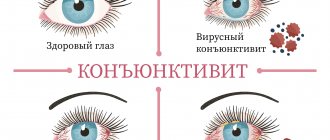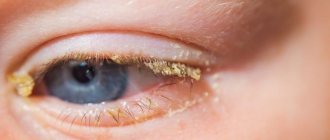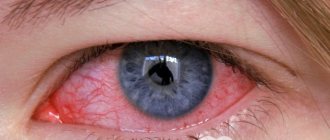Chronic bacterial conjunctivitis: complications
Treatment is based on the causes of inflammation, and they can be very different: from viral infection to allergic reactions. Therefore, you cannot do without professional diagnostics.
In this article
To understand how to treat conjunctivitis in an adult or child, you need to determine its shape and type. Only an ophthalmologist can make a diagnosis. To identify the cause of its development, a specialist conducts a survey about diseases, working conditions and probable contacts with a carrier of a viral disease.
A study of discharge from the eye is also carried out: this method allows you to determine the causative agent of the disease. Sometimes additional consultations are carried out with other doctors, for example, an allergist.
If conjunctivitis is mild, it can be cured fairly quickly, and the danger is not the disease itself, but the possibility of its spread. Following the rules of hygiene will help reduce the risk of the disease spreading to the healthy eye and other people. Among them:
- using your own towels and pillowcases;
- regular hand hygiene;
- avoiding contact with other people and visiting public places;
- avoiding contact of chlorinated water with eyes.
Conjunctivitis will not be so difficult to cure with the right approach. Most often, bacterial conjunctivitis occurs in children, since they usually neglect hygiene and touch their eyes with dirty hands. If a woman has a bacterial infection, the disease can also affect her newborn baby.
How to get rid of conjunctivitis? The first measure in the rapid treatment of bacterial conjunctivitis is the use of antibacterial drops that eliminate pathogenic microorganisms. Among the most commonly prescribed antibacterial agents:
- "Floxal";
- "Tobrex";
- "Oftadek";
- "Albucid";
- "Tsipromed", etc.
For conjunctivitis during pregnancy, antibiotics are selected individually, taking into account the characteristics of the course of pregnancy. Before carrying out the procedures, you need to wash the eyes, since the lacrimal glands do not always cope with this task on their own. Sometimes there is so much purulent discharge that it sticks together the eyes. This usually occurs during the acute stage of development of conjunctivitis. An infusion of chamomile and a solution of furatsilin are suitable for rinsing.
If drops for conjunctivitis do not help and the acute course of the disease drags on, you need to treat it with ointments. They are placed behind the eyelid, after which the patient should close his eyes and make rotational movements. Most often, tetracycline ointment is used for these purposes, which effectively affects pathogenic microorganisms.
The course of treatment is quite long - up to 14 days. This is due to the complexity of treating purulent conjunctivitis and frequent relapses. You cannot make a decision on stopping treatment on your own, since untreated conjunctivitis can arise with renewed vigor.
Early signs of conjunctivitis are often confused with eye fatigue, because the eyes dry out, bake, itch, and slight redness is visible, as happens with excessive strain on the visual apparatus. If adequate assistance is not provided in the first hours of the disease, the disease develops rapidly. Conjunctivitis is especially pronounced in adults in the morning, when swollen eyelids and mucous membranes of the eyes do not allow full vision, and visual acuity worsens. In this case, there is profuse lacrimation, photophobia and pain in the eye area.
Why does conjunctivitis appear in adults? Does the contact of pathogenic bacteria with the mucous membrane of the eyes always lead to the development of the disease? No, in most cases, the body’s protective functions manage to neutralize the effect of bacteria, and only with weak immunity will the disease manifest itself in full force. Typically, in adults, bacterial conjunctivitis develops against the background of prolonged colds, chronic diseases and stress.
What else can cause the development of chronic conjunctivitis:
- adverse effects on the body of low or high temperatures (hypothermia, overheating);
- “dry eye” syndrome, non-compliance with the rules and regimen of wearing contact lenses;
- systemic diseases of the body;
- untreated diseases of the nasopharynx, otitis, tonsillitis, etc.
What should be the treatment for conjunctivitis? Is it possible to treat the disease yourself by brewing herbs and teas to relieve swelling? Treatment of conjunctivitis in adults with folk remedies is used only to reduce symptoms, since the disease cannot be completely cured without antibacterial drugs.
What should other healthy household members do to avoid conjunctivitis? Interaction with a sick person should be careful and close contact should be avoided. You can become infected with conjunctivitis through contact with someone who is already sick, as well as through household items (towels, scarves, flash drives, smartphones, computer mice), so careful hand hygiene is important.
Unlike viral conjunctivitis, bacterial conjunctivitis is accompanied by a large amount of discharge. In addition to redness and itching, swelling of the eyelids, there is green or yellow discharge, which can be observed in the morning in the form of crusts, due to the fact that they dry out during the night. You can wash your eyes using folk remedies: decoctions, herbal infusions.
Bacterial conjunctivitis in adults - how the disease manifests itself:
- redness of the conjunctiva, itching, unpleasant sensations of dryness and burning in the eyes;
- pain and swelling of the eyelids, formation of films, gluing of eyelashes;
- narrowing of the palpebral fissure, copious and viscous purulent discharge;
- photophobia, lacrimation, increased body temperature - these symptoms often appear with conjunctivitis in adults.
Folk remedies can also be useful. Compresses based on herbs effectively relieve swelling, warm decoctions can be used to wash the eyes, but such treatment of conjunctivitis in adults should not be the main one, since herbs cannot fight bacteria, and the disease will progress. A long course of the disease can lead to dangerous complications, and in order to begin treatment for chronic conjunctivitis, additional tests will be required.
Inflammation of the mucous membranes of the eyes and eyelids, if treated incorrectly or insufficiently, can lead to serious complications. It is important that the treatment of chronic conjunctivitis is carried out by a specialized specialist who will determine the type of disease and select appropriate medications.
How to treat bacterial conjunctivitis in an adult? Due to the seriousness of this disease, treatment is started quickly, sometimes without waiting for a response from the laboratory, in order to reduce the likelihood of complications. In this case, broad-spectrum antibiotics are prescribed. Why is conjunctivitis dangerous? If treatment for bacterial conjunctivitis is not started in a timely manner and not only with folk remedies, but with medications, the disease can be complicated by keratitis, clouding and inflammation of the cornea of the eye, then affecting the inner layers of the cornea, which leads to scarring and decreased vision.
Why should conjunctivitis be treated surgically? Due to the loss of time during the acute period of the disease, when the disease could be overcome in one week, conjunctivitis continues to develop and becomes chronic, and the treatment of chronic conjunctivitis is not quick. All this negatively affects the general condition of a person and weakens the protective functions of the body.
All prescriptions for a patient with bacterial conjunctivitis are written out only after the tests have been received and analyzed. Diagnosis of the disease may include a cytological examination of a scraping, a bacteriological examination of an eye smear separated from the conjunctiva, and a blood test for sensitivity to antibiotics.
A serological test is carried out if the doctor suspects that the disease is caused by a virus and was complicated by the development of a bacterial infection. With this study, the discharge from the eye is checked for the presence of antibodies. If a specialist suspects allergic conjunctivitis, a series of allergy tests are prescribed to determine the irritants that trigger the allergic reaction.
Eye conjunctivitis - treatment with medications, complex therapy:
- Drinking plenty of fluids - in the first days of the disease, an increase in body temperature is possible, which is accompanied by dehydration, which contributes to the drying out of the mucous membranes and increases the soreness of the eyelids.
- The use of anesthetic eye drops is necessary so that the patient can painlessly apply medicinal ointments under the lower eyelid.
- Antibacterial agents: eye drops and ointments, antibiotics - with this eye treatment, the symptoms of the disease go away quite quickly.
- Rinsing the eyes several times a day with a solution of furatsilin - a disposable sponge is moistened in the solution and wiped the eyes from the outside to the inside.
How is conjunctivitis treated in adults? What conditions must be observed during therapy? Before instilling eye drops, you should always clean the eyelids of accumulated secretions - you can wash your eyes with herbal decoctions or by dissolving one furatsilin tablet in a cup of warm water. Since eye drops are stored in the refrigerator, before using them, the drops must be taken out in advance so that their temperature is close to room temperature.
- Lead a healthy lifestyle, avoid hypothermia, observe a sleep and rest schedule - the body, accustomed to a strict routine, increases its protective functions.
- Organize a balanced diet - you can include herbal teas according to folk recipes in the diet of adults; the diet should be enriched with foods that are healthy for the eyes, it should include dishes with carrots, spinach, fish, seaweed, egg yolk, and legumes.
- Daily exercise for the eyes - often the cause of bacterial conjunctivitis is eye fatigue from the computer, drying out of the mucous membrane, which is irritated and inflamed, which leads to a disruption of its protective functions, and special exercises will help restore blood flow to the organs of vision and moisturize them.
How does adenoviral conjunctivitis occur?
Adenovirus infection is a group of various diseases of infectious etiology caused by adenoviruses. They belong to the type of acute respiratory viral infections (ARVI), which affect the mucous membranes, including the upper respiratory tract and eyes. Infection with such diseases occurs through airborne droplets. If the virus enters the conjunctiva, inflammation develops.
The direct culprits of the pathology are adenoviruses. The following factors indirectly influence its development:
- weakened immune system;
- poor cleaning of scheduled replacement contact lenses;
- eye injuries;
- failure to comply with hygiene rules;
- swimming in bodies of water where the water quality does not meet sanitary standards;
- stress, lack of sleep, overwork.
Symptoms of this type of viral conjunctivitis can be divided into two groups: ophthalmological and non-ophthalmological. The first include: mucous discharge, redness of the conjunctiva and eyelids, burning, pain, pain in the eyes, a feeling of “sand,” photophobia, swelling, vascular mesh on the cornea, increased lacrimation.
Symptoms of the second group include signs characteristic of ARVI:
- increased body temperature;
- runny nose;
- cough;
- headache;
- enlarged lymph nodes;
- weakness, general malaise.
At the very beginning of the disease, a person is bothered by these symptoms. Inflammation on the connective membrane appears on days 2-3. The disease occurs in one eye, but can subsequently spread to the second. Depending on the course of conjunctivitis provoked by adenoviruses, its symptoms may change. Let us examine separately the types of adenoviral inflammation of the conjunctiva.
What medications does a doctor prescribe for bacterial conjunctivitis?
In this article
A disease such as conjunctivitis can occur in adults and children. It is most often infected in autumn and winter, when human immunity decreases. The main means of combating the disease in this form are interferon drops and antiviral drugs in tablet form. If eye damage in an adult patient is caused by the herpes virus, Ophthalmoferon, Tebrofen, Laferon and other drugs are prescribed.
The greatest danger with viral conjunctivitis is dry eye syndrome. The lacrimal glands stop producing secretions that moisten the mucous membrane. As a result, any movement of the eyelid leads to severe irritation. To relieve unpleasant symptoms, it is recommended to use artificial tears.
When the acute course of the disease has stopped, it is worth intensifying treatment with immunostimulating drugs. They will help get rid of sluggish conjunctivitis and will be an excellent preventive measure.
Is the prevention of conjunctivitis effective with folk remedies? Yes, various drinks based on berries, rose hips, and herbs are especially useful. Herbal teas are useful for strengthening the immune system; they are used in the treatment of adults with folk remedies. They are highly effective with a cumulative effect, that is, chamomile, mint, etc.
Frequent causes that provoke the development of bacterial and viral conjunctivitis:
- complication of colds and viral diseases;
- hypothermia, overheating of the body;
- reduced immunity, chronic diseases, systemic disorders;
- infection through a medical instrument during diagnosis or treatment of other ophthalmological diseases can also cause viral or bacterial inflammation of the eye mucosa;
- dry eye syndrome, which occurs as a result of excessive visual stress, can lead to viral or bacterial conjunctivitis;
- contact lenses, rules for their cleaning and disinfection.
Why do some people often become infected with bacterial or viral conjunctivitis, while others do not? In order for pathogenic flora to overcome the natural barriers of the body, appropriate conditions must be created for the life of bacteria. The human visual organs become vulnerable if the amount of tear fluid is insufficient.
This usually happens with dry eye syndrome, ophthalmological problems, reduced immunity, during dry, hot and windy weather, when the mucous membrane of the eye dries out, as well as colds accompanied by elevated temperature, which causes a lack of moisture in the body and a person feels discomfort in the eyes. Remember that if folk remedies do not help relieve irritation, and the symptoms increase, you should urgently contact an ophthalmologist.
Symptoms of bacterial conjunctivitis in adults and children:
- With conjunctivitis, the mucous membrane of the eye becomes inflamed, there is profuse lacrimation, itching and pain.
- The appearance of purulent discharge, the inability to open the eyes after sleep due to sticky eyelids. Start treatment with folk remedies for conjunctivitis in the morning, cleansing your eyes with herbal infusions or furatsilin solution.
- Swelling of the eyelids, redness of the eyes, photosensitivity - to eliminate these symptoms, you can begin treatment with popular folk remedies in combination with eye drops and antimicrobial ointments.
- General malaise, headaches, and possible fever are common symptoms of conjunctivitis, because this is how the effect of toxins released by bacteria manifests itself.
Yellow pus occurs as a result of tissue damage by bacteria; it is secreted from small blood vessels due to their increased permeability during illness and consists of microbial cells, enzymes of microbial origin, and fats. When diagnosing bacterial conjunctivitis, a laboratory examination of scrapings from the conjunctiva is carried out and, thus, the causative agent of the disease is determined.
Laboratory tests help not only to identify the bacteria that cause conjunctivitis, but also to select an antibiotic that will be most effective in treating this disease. Bacterial conjunctivitis most often occurs in an acute form. If you rely only on folk remedies for conjunctivitis, the disease can become chronic and then treatment will take not 7-10 days, but more than one or even two months if serious complications arise.
Due to constant swelling of the eyelids, their skin is damaged, which leads to the appearance of blepharitis, which is long and difficult to treat. With blepharitis, symptoms such as itching, redness and swelling of the eyelids are noted, which causes severe discomfort to the person. Keratitis is an inflammation of the cornea that can affect not only its superficial layers, but also its deep ones.
Classification
Depending on the type of “pest” that caused the development of inflammatory processes in the organ of vision, the disease is divided into the following categories:
- Gonococcal;
- Staphylococcal or streptococcal;
- Pseudomonas aeruginosa.
The first type of purulent conjunctivitis in infants develops three days after birth from an infected mother infected with gonorrhea. This pathology is extremely rare, since pregnant women undergo a thorough medical examination before childbirth. This phenomenon can be encountered in asocial families where the expectant mother did not consider it necessary to register with the antenatal clinic.
| The disease can be transferred from the genitals to the organ of vision by the sick person himself. The main danger of gonococcal conjunctivitis lies in the fact that it affects the cornea. If treatment is not started in time, you can permanently lose your vision. |
To become infected with a staphylococcal or streptococcal disease, only minor contact with a carrier of the infection (for example, shaking hands) is enough. It is also dangerous to use things and personal hygiene items that the patient has touched. In addition, this type of conjunctivitis affects the body after suffering an inflammatory disease of the upper respiratory tract.
The acute period lasts from one to two weeks. The clinical picture develops very quickly, with pronounced symptoms. If treatment is not started in time, the anomaly will enter the chronic stage. In this case, the abundance of discharge decreases, the signs become almost invisible, but the pathology is difficult to treat.
Pseudomonas aeruginosa enters the body as a result of microscopic damage to the visual apparatus, if the rules for storing and wearing contact lenses are violated due to the penetration of dust and dirt into the eyes. As a rule, this type of purulent conjunctivitis affects only one eye.
The initial signs of pseudomonas inflammation are increased sensitivity to light and increased lacrimation. Then pus is released, erosions form on the surface of the cornea, through which the infection enters the deeper layers of the eye. In some cases, progression of keratitis is observed. Subsequently, scars appear at the site of erosion, significantly reducing visual acuity.
Return to contents
Causes
The causes of the disease can be bacteria, viruses, allergic reactions, and improper personal hygiene.
It must be remembered that conjunctivitis is a contagious disease. Very often it is transmitted from one person to another. This can be avoided if you follow these basic rules:
- Use only your personal belongings, cosmetics, etc.
- Wash your hands and eyes after contact with someone with conjunctivitis.
- Try to avoid getting bleach in your eyes.
- After meeting someone with conjunctivitis, do not touch your face with your hands.
To know how to quickly cure conjunctivitis, it is important to correctly determine its nature. Symptoms of the disease differ depending on the causes of its occurrence:
- Viral conjunctivitis can occur in one or both eyes at once. The patient suffers from photosensitivity. This form of the disease is extremely dangerous because it quickly spreads to healthy people and is difficult to treat. The main efforts should be aimed at preventing its complications.
- Bacterial conjunctivitis: It is accompanied by purulent or mucous discharge that accumulates in the corner of the eye. Like the previous type of conjunctivitis, bacterial can affect one or both eyes and is contagious.
- Allergic conjunctivitis: accompanied by other symptoms of an allergic reaction, such as nasal congestion. The disease develops in both eyes, is not transmitted to other people and responds well to treatment.
What to do with conjunctivitis occurring in each of these forms will be discussed later in this article.
The main reasons for the development of the disease include:
- Infectious diseases that have reduced immune defense. Very often, conjunctivitis appears during a cold or immediately after it.
- Poor hand hygiene, as well as the habit of touching your face. Such a person is likely to develop not only conjunctivitis, but also acne, as well as other inflammatory diseases of the face.
- Allergy. Allergic manifestations in the eye area, especially in girls, often appear. This is due to the abundance of makeup products they use.
- Dry eye syndrome. It usually occurs from overexertion caused by spending too long in front of a monitor screen. The person blinks less often, and the eye muscles begin to spasm. All this leads to stagnation and a decrease in the supply of nutrients to the tissues.
Prevention
Since allergic conjunctivitis is a chronic disease, it is necessary to take the following preventive measures:
- limit contact with the allergen;
- wear sunglasses when outdoors;
- during an exacerbation of conjunctivitis, do not use lenses;
- observe the rules of personal hygiene;
- avoid unnecessary contact of hands with eyes;
- use a different pipette, napkin, drops, etc. for each eye;
- Use exclusively your own towel, lenses, and cosmetics.
If you follow all recommendations and timely therapy, allergic conjunctivitis can be successfully treated at home, without unnecessary medical intervention.
How to wash your eyes
Most often, staphylococci, streptococci, gonococci, pneumococci, and diphtheria bacilli are found in eye diseases. All these microbes can affect not only the conjunctiva, but also other parts of the eye. Therefore, treatment with folk remedies for conjunctivitis is not always effective without the use of antimicrobial drugs.
If the organs of vision function normally, and the lacrimal gland secretes a sufficient amount of moisture, then there are no conditions for the spread of microbes, since tears have an antibacterial effect. Lysozyme, which is part of the tear fluid, neutralizes the effects of bacteria and viruses, preventing toxins from having a detrimental effect on the body.
When the body's defenses are weakened, bacteria can spread rapidly and can only be combated with antimicrobial drugs. Unfortunately, it will not be possible to cope with a bacterial eye infection with folk remedies. Streptococcus, overcoming the natural barriers of the body, spreads and releases toxins, which, when released into the blood, can cause, in addition to conjunctivitis, other inflammatory processes, which leads to general intoxication of the body.
How to treat bacterial conjunctivitis? The harmful effects of bacteria must be stopped as soon as possible, since the poisons they secrete can dilate blood vessels and destroy blood cells, negatively affect white blood cells, reducing the body’s ability to resist infections, and also secrete enzymes that help bacteria spread quickly.
This is why bacterial conjunctivitis is treated with broad-spectrum antibiotics, and their use is not only desirable, but actually necessary. Eye lotions based on herbal decoctions, compresses - all these folk remedies can only ease the symptoms for a while, but are not able to eliminate the cause of the disease. Acute bacterial conjunctivitis can only be cured with antibiotics.
Antimicrobial drugs are effective against bacteria, their action is aimed at eliminating the cause of the disease. You can also fight symptoms such as swelling of the eyelids and inflammation of the conjunctiva with folk remedies. Use traditional recipes with extreme caution if you are prone to allergies, since an allergic reaction to any component of herbal preparations for the treatment of conjunctivitis is not uncommon.
Inflammation of the mucous membrane of the eyes: treatment with folk remedies:
- Black and green teas for washing eyes (brew tea for no more than 5 minutes) are one of the most popular methods of folk treatment; You need to wash your eyes with warm liquid so that the pus that has dried after sleep can be easily separated.
- Decoctions of chamomile and calendula flowers (the liquid must be filtered several times through a folded piece of gauze) are often used in the treatment of chronic conjunctivitis with folk remedies; they can be used both to cleanse the eyes of pus, and you can make warm compresses with them - this will facilitate the outflow of pus.
- Dill, bay leaves, fennel seeds - these components of medicinal decoctions have antiseptic properties and help relieve inflammation and swelling of the eyelids due to conjunctivitis, therefore they are often included in folk treatment recipes.
- Brew crushed chamomile flowers in a glass of boiling water, cool, and then dip a cotton swab into the liquid and squeeze out a little - it is better to do such lotions in the evening, before going to bed; apply compresses to your eyes for 2-3 minutes, covering them with a towel; the procedure can be repeated 3-4 times.
- Blue cornflower flowers can also be used for lotions at home - to do this, pour boiling water over a tablespoon of crushed flowers (0.5 liters are needed) and boil for 2-3 minutes, and then infuse for an hour.
Eye conjunctivitis: treatment with folk remedies - effective or not? Lotions with herbal decoctions and warm compresses are an effective remedy that is often used in medical therapy. Lotions can relieve puffiness, and washing the eyes with herbal teas that have antiseptic properties will make it easier to cleanse the eyelids of purulent discharge and soothe the skin.
Sometimes even experienced doctors are not able to find answers to all questions. But you shouldn’t give up here either. Traditional medicine will help fight eye inflammation. Treatment of conjunctivitis can be carried out using various lotions, drops and infusions. All of them are effective to one degree or another. But better results can be achieved by using them alternately. This way you can find a remedy that will effectively fight the disease.
If you can’t overcome chronic conjunctivitis, treatment with folk remedies can provide the last hope for recovery. After all, even where medications do not produce any results, “grandmother’s recipes” can help.
Furacilin is an excellent remedy for treating inflammation of the eye membrane. But in this case, it is still very important to know how to dilute furatsilin for eye rinsing. After all, an incorrectly made solution can only harm the patient.
In many pharmacies you can find a pre-prepared solution. But in most cases, the patient can only find this medicine in tablets. It takes time to dilute them, so before diluting furatsilin to wash the eyes, you must first prepare everything.
Boil 2 glasses of water, put 2 furatsilin tablets there. They get divorced for a very long time. Therefore, you will need to wait several hours. To make the procedure faster, you can crush the tablets. Before rinsing your eyes, the prepared solution must be filtered. As with tea or other herbal infusions, small particles of the ingredients may get into your eyes. Therefore you need to be extremely careful.
In this article
Please note these requirements:
- Use a 20% solution of albucid or 0.3% solution of chloramphenicol. The products must be instilled behind the lower eyelid, 1-2 drops. It is recommended to repeat the procedure every 3 hours. For preventive purposes, you can also instill drops into a healthy eye, but to avoid infection, it is better to do this with a healthy pipette.
- Avoid exposure to bright light; if present, it is recommended to wear sunglasses.
- There is no need to put a blindfold on your eyes.
Conjunctivitis is an inflammation of the mucous membrane of the eye. Irritation causes blood vessels to dilate, causing the eye to turn red. The causes of the development of the disease depend on its form: it can be an allergic reaction, or a consequence of a viral or bacterial infection. In any case, it is accompanied by unpleasant symptoms, and therefore it should be cured as soon as possible.
To get rid of conjunctivitis, you can use not only pharmaceutical drugs, but also folk remedies. They have an equally strong effect, but they should only be used in conjunction with medications. The most effective:
- Chamomile infusion has a gentle effect on the eyes, but at the same time perfectly relieves the inflammatory process. To prepare it, you need to take a spoonful of the dry plant and pour a glass of boiling water. The product must be infused for several hours. Chamomile infusion is used for rinsing and as a lotion on the eyes, which is done for 15-20 minutes up to 5 times a day.
- You can also use regular tea. This remedy is even used to treat a newborn child. It is necessary to brew tea, moisten a cotton pad in it and apply it to the inflamed eyes, removing mucous and purulent discharge from them.
- Dill juice therapy - this remedy has a specific smell. To prepare it, you need to take a bunch of dill, chop it and squeeze out the juice. Soak a cotton pad in the liquid and apply it to the eyes for 15 minutes.
- Dill seeds, horsetail, chicory and marshmallow root are taken in equal quantities and mixed. A tablespoon of the mixture is poured into a glass of boiling water. After the infusion has cooled, a disc is moistened in it and applied to the eyes. Before this, instill a few drops of the product.
- Pour two teaspoons of ground rose hips into a glass of water, bring to a boil and remove from heat. When the broth has cooled, rub your eyes with it. Repeat the procedure up to 4 times a day.
It is worth noting that the use of each remedy should be coordinated with your doctor. Conjunctivitis is a complex ophthalmological disease that, without proper and timely treatment, can lead to serious complications. These include complete loss of vision and soft tissue necrosis. After getting rid of the disease, you should remember about preventive measures and do not forget to apply them.
Eye conjunctivitis - treatment with traditional recipes, is it possible or not? All described cases where conjunctivitis in an adult resolved after several procedures of washing the eyes with herbal infusions and decoctions are associated with ordinary eye fatigue or minor inflammation. It happens that the mucous membrane, irritated by wind, dust, and dry air, becomes painful, and after moisturizing it is restored and returns to its normal state.
Swelling of the mucous membrane and conjunctivitis - will folk remedies be effective for such a disease or not? There is no need to completely abandon the use of folk remedies, because, indeed, decoctions of parsley, calendula, and chamomile relieve inflammation and swelling well, alleviating the condition of a sick person.
- Crushed chamomile and calendula flowers are poured with boiling water and infused for half an hour, then the broth must be filtered and used warm to wash the eyes - such folk remedies are considered natural antiseptics, so they are often used.
- A decoction of dill and fennel seeds relieves swelling of the eyes; it can also be used to wash the eyes and use for compresses.
- Compresses with decoctions of a mixture of herbs: blue cornflower, eyebright, clover (you can add a few drops of rosemary oil).
- Fresh aloe juice and Kalanchoe are familiar folk remedies that can be used to relieve itching and inflammation of the eyelids; Apply a little juice to a cotton swab and gently wipe your eyes with it.
- Rubbing the eyes with a strong infusion of black and green tea, decoctions of bay leaves - these plant components have natural antiseptic properties and have an anti-inflammatory effect.
Tea treatment methods
One of the ways to treat conjunctivitis using traditional methods is to use tea as a rinsing agent.
An eye wash infusion can be made from black and green tea, using them in equal proportions. Add a tablespoon of grape wine (preferably dry) to a glass of this mixture. You need to wash your eyes with this solution quite often. You can stop treatment only after complete recovery.
Before rinsing your eyes with tea, you should strain it and make sure that there are no small tea leaves or any other solid debris in the solution.
You never know who already remembers the ancient recipe of traditional medicine that was used by our grandmothers. We are talking about a compress made from raw potatoes. To do this, you need to grate it and mix it with egg white. Apply the compress for 10–15 minutes. Repeat the procedure for several days.
A decoction of bay leaves helps with conjunctivitis. Several of them need to be poured with fresh boiling water, left for half an hour and cooled. You should use this product to make lotions or simply wash your eyes with it.
Aloe will be a good helper in the treatment of conjunctivitis. The juice of this medicinal plant destroys bacteria well. It should be used for bacterial conjunctivitis.
Leave several large aloe leaves in the freezer for a couple of hours. After this, chop the leaves and squeeze out all the juice. Before going to bed, place swabs soaked in aloe juice on your sore eyes. Keep for 15 minutes.
Be healthy!
Tea recipes
Many people wonder how to wash a child’s eyes with tea and is it possible to do this at all? It is possible, but it is necessary to observe certain proportions. To do this, it is better to choose the following recipe.
Brew a bag of black tea in a glass of boiling water. Leave it for no more than a minute. Afterwards, wipe your eyes with this infusion 3-6 times a day. Tampons should be changed every time.
This recipe is also suitable for adults. Only the proportions of tea need to be increased.
Very often, when treating conjunctivitis with folk remedies, tea bags are used, which are placed directly on the eyes. This method can be effective, but it should not be used on children. The bag may become wet and tea leaves may get into your eyes. Adults need to watch the bag and avoid it breaking.
Useful tips
To avoid the development of conjunctivitis and speed up recovery, doctors recommend:
- Rinse eyes with clean water. This will relieve tension, clean and moisturize the surface of the sclera.
- Regularly take vitamin complexes with ascorbic acid. It strengthens small vessels, which will prevent damage to their integrity and redness of the sclera.
- If alkaline solutions get into your eyes, you must immediately rinse them with a concentrated sugar solution. This will neutralize the alkali and prevent it from corroding the mucous membrane.
- If a speck has entered the eye, it can only be removed with a clean, soft cloth. You should not rub your eye or touch the sclera or eyelids with your fingers.
By following these simple tips, you can significantly reduce the risk of damage to the mucous membranes of the eyes and infection with pathogenic bacteria.
Treatment of conjunctivitis with chamomile solution
Chamomile can be used to make a variety of lotions, compresses and eye wash solutions. It has a calming and anti-inflammatory effect.
Before rinsing your eyes with chamomile, you should make sure that the patient is not allergic to this plant. Such a reaction from the body will only make the situation worse. And with allergic conjunctivitis, it can simply be a disaster. Therefore, it is better to use chamomile decoction for a bacterial or viral disease.
Chamomile lotions will be very useful. You need to steam the plant with boiling water and cool slightly. Soak a swab in the solution and apply it warm to your eyes. It is important to do this procedure in the evening. Then your eyes can have a good rest. You need to cover your face with a towel and hold the lotion for several minutes. Then change it and repeat the procedure. You can make 4-5 lotions at one time.
Chamomile compresses also help with conjunctivitis. To prepare it, you need to brew a handful of plant flowers with 1.5 liters of water. Let cool, strain. Add a few drops of chamomile oil to the infusion. Apply the prepared mixture to a tampon or a piece of natural fabric. Apply the compress in the evening to sore eyes.
There are several tips on how to wash your eyes with chamomile. They are all similar. They differ only in the size of the proportions and the number of treatments. Let's consider one of them.
Pour boiling water over 2-3 tablespoons of chamomile flowers. Boil for a few minutes, let it brew. Rinse the affected eye 6-7 times throughout the day.
Treatment of conjunctivitis with herbs
There are a large number of medicinal herbs, the correct preparation of which can help quickly and effectively cure conjunctivitis. Among them are celandine, cornflower, agrimony, calendula, etc.
A decoction of blue cornflower will help effectively deal with the disease. To do this you will need 4 tablespoons of the flowers of this medicinal plant. Pour 1 liter of fresh boiling water over them and cook for another 4-5 minutes over low heat. Leave for a couple of hours. Then strain. You can wash your eyes with the decoction. It is also recommended to do frequent lotions. The manipulation should be repeated at least 5 times throughout the day.
To make a medicinal infusion from celandine, you will need 4 teaspoons of this plant and 2 teaspoons of fragrant violet. The mixture must be poured with boiling water and allowed to brew for at least an hour. This medicine can be used for compresses. Or you can take it internally. Drink half a glass of decoction 3-4 times a day.
Treatment of conjunctivitis with folk remedies can also be carried out using a mixture of herbs. You need to take 70 grams of blue cornflower and calendula officinalis, add to them 60 grams of the herb eyebright. It is better to use dry inflorescences of these herbs. Grind all this and mix well. Every 2 tablespoons, pour half a liter of hot water into the mixture. Leave for 35 minutes, then strain. Use the infusion to prepare a compress for the eyes. This product can be used for quite a long time.
You can wash sore eyes with conjunctivitis with an infusion of the eyebright herb. Pour 2 cups of boiling water over 1 tablespoon of chopped plant. Leave for half an hour. Strain. You need to rinse with warm broth.
An infusion of clover flowers can be used as lotions and compresses. Pour boiling water over one tablespoon of inflorescences, leave and strain.
A decoction of dill seeds has an excellent effect on the eyes with conjunctivitis. It is suitable for preparing compresses and lotions. They can be used to rinse the eyes.











